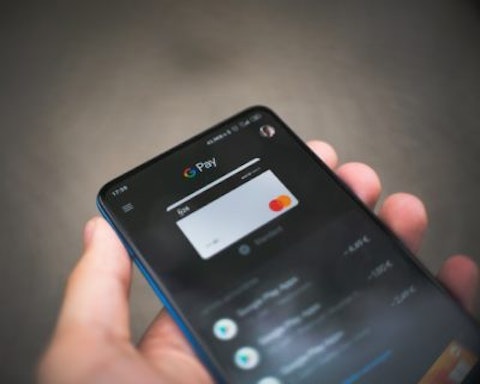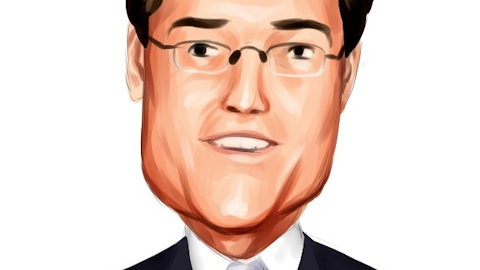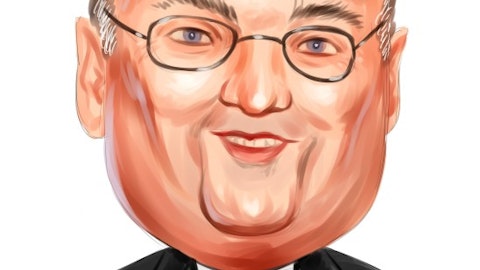Block, Inc. (NYSE:SQ) Q2 2023 Earnings Call Transcript August 3, 2023
Block, Inc. beats earnings expectations. Reported EPS is $0.39, expectations were $0.35.
Operator: Good day, ladies and gentlemen, and welcome to the Block Second Quarter 2023 Earnings Conference Call. I would now like to turn the call over to your host, Nikhil Dixit, Head of Investor Relations. Please go ahead.
Nikhil Dixit: Hi, everyone. Thanks for joining our second quarter 2023 earnings call. We have Jack and Amrita with us today. We will begin this call with some short remarks before opening the call directly to your questions. During Q&A, we will take questions from our customers in addition to questions from conference call participants. We would also like to remind everyone that we will be making forward-looking statements on this call. All statements other than statements of historical fact could be deemed to be forward-looking. These forward-looking statements include discussions of our outlook and guidance, as well as our long-term targets and goals, and we may decide to shift our priorities or move away from these targets and goals at any time.

These statements are subject to risks and uncertainties. Actual results could differ materially from those contemplated by our forward-looking statements. Reported results should not be considered as an indication of future performance. Please take a look at our filings with the SEC for a discussion of the factors that could cause our results to differ. Also, note that the forward-looking statements on this call are based on information available to us as of today’s date. We disclaim any obligation to update any forward-looking statements except as required by law. During this call, we will provide preliminary estimates of gross profit growth, GPV, and GMV performance for the month of July. These represent our current estimates for July performance as we have not yet finalized our financial statements for the month of July and our monthly results are not subject to interim review by our auditors.
As a result, actual July results may differ from these estimates and may not be reflective of performance for the full third quarter. Moreover, this financial information has been prepared solely on the basis of currently available information by and is the responsibility of management. This preliminary financial information has not been reviewed or audited by our independent public accounting firm. This preliminary financial information is not a comprehensive statement of our financial results for July or the third quarter. Within these remarks, we will also discuss metrics related to our investment framework, including Rule of 40. With Rule of 40, we are evaluating the sum of our gross profit growth and adjusted operating income margins. Also, we will discuss certain non-GAAP financial measures during this call.
Reconciliations to the most directly comparable GAAP financial measures are provided in the shareholder letter, historical financial information spreadsheet, and Investor Day materials on our Investor Relations website. These non-GAAP measures are not intended to be a substitute for our GAAP results. Finally, this call in its entirety is being audio webcast on our Investor Relations website. An audio replay of this call and the transcript for Jack and Amrita’s opening remarks will be available on our website shortly. With that, I would like to turn it over to Jack.
Jack Dorsey: Thank you for joining us today. I’ll spend my time today highlighting the progress we’ve made on two themes; first, our investment framework, and second, our ecosystem of ecosystems model. You’ll find everything else from the quarter in the shareholder letter we posted an hour ago. As we shared earlier this year, we define our investment framework as Block and each ecosystem must show a believable path to gross profit retention of over 100% and Rule of 40 on adjusted operating income. Today, I wanted to share our progress towards this target and demonstrate how our investment framework forces us to make trade-offs and guides our decision-making across the company. Leaders across our company are now looking at the true full-cost of their businesses, inclusive of share-based compensation.
This has led us to pull back on our pace of hiring to be more targeted in hiring for critical roles and to focus more on performance management. For sales and marketing, we are focused on efficiency to drive acquisition while decreasing spend. We’ve pulled back on-brand spends and more experimental channels across our ecosystems in favor of channels with more proven returns. This past quarter, we also decided to wind down operations in certain markets, including Cash App’s diverse brands in the EU and our Buy Now, Pay Later platform, Clearpay in Spain, France, and Italy. These required significant investment and the markets have not seen the growth and profitability we had expected over the past several years. We see an opportunity to shift these resources towards strategic areas that have a higher potential return on investment.
And we continue to drive towards our goal, we may identify other areas where we aren’t seeing the expected and necessary returns. We also continue to improve our cost structure for each of the ecosystems by identifying opportunities to expand our structural margins. These include the investments we make in technologies like automation and machine learning to manage risk, and finding ways to optimize our partnerships. As a result of our investment discipline, we are increasing our profitability expectations for this year, which Amrita will speak about. We’ll continue to share updates with you as we make progress towards our target. As a company, our strength and resilience comes from our diversified ecosystems, each serving different audiences and the connections we create between them.
There are some notable examples of this work in the second quarter. In June, we turned on Cash App Pay as a payment method for Square invoices, giving customers the ability to pay outstanding invoices directly from their Cash App balance. In the second quarter, we launched Cash App Pay with several well-known Afterpay sellers, expanding the connection between Cash App and our Buy Now, Pay Later platform, and also recently launched strategic partnerships with payment providers Stripe, Adyen, and PayNearMe, an important step-in reaching a wider range of merchants. We started enabling Square Payroll employees to file taxes for free by using automated [W2] (ph) import directly in the Cash App Taxes. After receiving a notification from Square Payroll, employees simply log into Cash App Taxes, securely import their W2, and complete and submit their tax forms.
Earlier this year, we shared plans for the public beta testing of our Bitcoin Wallet, Bitkey. And in June, we announced our first two global partners, Coinbase and Cash App to allow customers to buy and immediately transfer Bitcoin from those custodial platforms into Bitkey’s self-custody wallet. I’ll now pass it to Amrita who will provide more details on our financials.
Amrita Ahuja: Thanks, Jack. There are three topics I’d like to cover. First, an overview of our strong second quarter results across growth and profitability. Second, trends we’re seeing across our business in July. And third, a look at our investment discipline and profit expectations for the remainder of the year. In the second quarter, we had strong growth at scale with gross profit of $1.87 billion, up 27% year-over-year. Our strong profitability this quarter is a demonstration of our ability to drive leverage and operating efficiency in our business. Adjusted EBITDA was $384 million, more than two times year-over-year. Adjusted operating income, which, as a reminder, includes expenses related to stock-based compensation and depreciation was $25 million compared to a loss of $103 million a year ago.
Let’s get into Square and Cash App. Square generated $888 million in gross profit, up 18% year-over-year. Looking at some of the drivers, gross profit from our vertical point-of-sale products was up 37% year-over-year, with each of our restaurants, retail, and appointments products delivering gross profit of more than $100 million on an annualized basis during the quarter. Square GPV was up 12% year-over-year, looking at the components of growth across retention, churn, and acquisition. GPV per existing seller, which effectively measures same-store growth has stepped down since the third quarter of 2022 and has been the primary driver of the moderation in GPV growth since then. We achieved positive growth in acquisition and saw relative stability in churn of existing sellers compared to historical levels.
We’re seeing strength in our Square banking products, which totaled $167 million in gross profit during the quarter, an increase of 24% year-over-year. Banking products represented 19% of Square gross profit excluding PPP, up from 17% in the prior year. The four biggest drivers of Square banking during the quarter were Instant Transfer, Square Debit Card, Square Savings, and Square Loans. We saw benefits from raising pricing on Instant Transfer earlier this year from recent launches of our banking products outside the U.S. and from interest on Square Savings balances. Lastly, for Square, growing up-market has remained strong with gross profit from mid-market sellers up 20% year-over-year. We believe the total addressable market for the larger sellers segment remains large and highly fragmented and our recent shift in go-to-market efforts is intended to drive further growth upmarket.
Cash App generated $968 million in gross profit, an increase of 37% year-over-year. Each component of our inflows framework, Actives, Inflows per Transacting Active, and Monetization Rate grew on a year-over-year basis. During the month of June, we reached 54 million monthly transacting actives, up 15% year-over-year. We’ve continued to see significantly higher attention for actives with larger network sizes. During the quarter, those with a network of four or more represented more than half of Cash App quarterly transacting actives. Peer-to-peer functionality has allowed us to scale our network rapidly and has driven engagement. In the second quarter, peer-to-peer transactions per actives reached an all-time quarterly high, which helped drive $53 billion in peer-to-peer volume across Cash App during the second quarter, an increase of 18% year-over-year.
Inflows per Transacting Active averaged $1,134 in the second quarter, up 8% year-over-year and relatively stable compared to the first quarter, which typically has a seasonal benefit from tax refunds. We believe there is significant runway for growth in Inflows per Transacting Active over time through increased product adoption and growing share of wallet. This tax season more than one-third of Cash App Taxes Actives chose to receive their refund directly into Cash App, a meaningful increase year-over-year, driving new actives to direct deposit. Product adoption has been especially strong for our financial services products, both Cash App Card and direct deposit experienced strong growth in actives and volumes. Monetization rate, which excludes gross profit contributions from our BNPL platform was 1.44%.
Monetization was up 16 basis points year-over-year, driven primarily by pricing changes over the past year, and up 3 basis points quarter-over-quarter, driven primarily by the timing of strong first quarter inflows during the tax season. Lastly, our BNPL platform contributed $84 million of gross profit to each of Square and Cash App in the second quarter. GMV from our BNPL platform was $6.4 billion in the second quarter, an increase of 22% year-over-year. Losses on consumer receivables were 1.01% of GMV, relatively consistent with the prior year. Next, an update on July trends. For the month of July, we expect total gross profit growth of 21% year-over-year, which we would orient you to for the third quarter and the remainder of 2023. Looking at each ecosystem, for the month of July, we expect Square gross profit to grow 15% year-over-year, which we expect to be relatively consistent through the third quarter.
The moderation in gross profit growth from the second quarter is primarily due to transaction margin compression as we lapse certain benefits from more favorable interchange economics last year. Square GPV is expected to be up 12% year-over-year, consistent with the second quarter as we’ve seen stability in GPV growth over the past three months from May through July. For the fourth quarter, we expect gross profit and GPV growth to improve slightly compared to the third quarter as Square benefits from more favorable comparisons. For Cash App, we expect gross profit to grow 27% year-over-year in July, and similar to Square, we expect it to be relatively consistent through the third quarter. In 2023, we continue to expect growth on a year-over-year basis from monthly Transacting Actives, Inflows per actives, and Monetization Rate.
We expect Cash App’s monetization rate in the back half of the year to be more consistent with the second quarter and we expect gross profit to grow more in line with the overall inflows as a result. Given the focus on efficiency, the wind down of Verse will have an impact on monthly actives going forward, although we do not expect an impact to inflows or gross profit. Four the fourth quarter we expect a slight moderation in Cash App’s gross profit growth, driven by stabilization in Cash App’s monetization rate, and as we lapse stronger growth in the prior year period. For our BNPL platform, we expect year-over-year GMV growth in July to be similar to the second quarter’s 22%, with GMV growing faster than gross profit due to regional mix. Turning to our progress against Rule of 40 and our profit expectations for the remainder of the year.
Our investment framework sets up an ambitious goal, and we’re focused on progressing towards it over the long-term. We’ll continue to share updates with you and hold ourselves accountable. Expanding on what Jack touched on, we’ve worked to deliver efficiencies through the first half of the year. On hiring, we drove leverage compared to our expectations entering the year by encouraging efficiencies among existing teams and prioritizing hiring in more critical areas. We expect our headcount growth in 2023 to be below the 10% target set out earlier this year. With sales and marketing, we’ve pulled back on lower ROI channels to increase our efficiency, while Cash App’s variable sales and marketing expenses namely peer-to-peer and Cash App Card issuance costs were up year-over-year, overall company customer acquisition spend was down year-over-year, driving leverage across Square and Cash App.
Despite this pull back, we saw healthy acquisition across each ecosystem as we shifted our mix of spend. And looking at corporate overhead spend, we began to identify cost savings opportunities by downsizing our real estate footprint across some of our West Coast office locations. Given some of these items on a GAAP basis, operating loss was $132 million in the second quarter, which includes the impact of acquisition-related amortization expenses, as well as restructuring expenses for the wind down of Verse and Clearpay in certain markets and write-downs for certain real estate facilities among other items. We expect to find further leverage opportunities in these and other overhead expenses over time. Moving to our full-year 2023 profit guidance.
As we have progressed further into the year, we have better line-of-sight into our planned expenses and our updated guidance today reflects this. We’re increasing our expectations for profitability in 2023 and now expect to deliver adjusted EBITDA of $1.5 billion and adjusted operating income of $25 million for the full-year 2023. We expect to achieve profitability on an adjusted operating income basis for the year, which is inclusive of share-based compensation expenses. We continue to expect year-over-year margin expansion on both an adjusted EBITDA and adjusted operating income basis. Our updated full-year guidance represents a step-up of $140 million for each figure compared to our prior guidance. This represents both the gross profit momentum in our business during the second quarter and the focus on expense discipline we delivered in the first half of the year, which we expect to continue to drive in the second half of the year.
Finally, touching on the third quarter, we expect third quarter non-GAAP operating expenses of $1.55 billion and we expect share-based compensation to increase by approximately $25 million relative to the second quarter. As Jack mentioned, share-based compensation remains an area on which we are focused and expect to drive greater leverage over time. We’re excited about the progress we’ve made towards our investment framework and Rule of 40 this quarter and are eager to continue to work. With that, I’ll now turn it back to the operator to start the Q&A portion of the call.
See also 10 Oversold Large Cap Stocks to Buy and 10 Oversold MidCap Stocks To Buy.
Q&A Session
Follow Block Inc. (NYSE:SQ)
Follow Block Inc. (NYSE:SQ)
Operator: Thank you. [Operator Instructions] We’ll take our first question from Tien-Tsin Huang at JP Morgan.
Tien-Tsin Huang: Hey, thanks so much here. So, given your July month update tracking a little bit slower than the second quarter and also your profit update which you raised. Just love to hear your updated thoughts on operating leverage. I know I asked that quite a bit, but just operating leverage here in the second half versus the first half. Is operating leverage going to be driven more by the top-line or by expense focus that you also talked about across the two ecosystems? Thanks.
Amrita Ahuja: Hey, thanks for the questions, Tien-Tsin. So obviously, as we see strong second quarter results across both top-line and profitability, we’re pleased with our ability to show discipline in our operating expenses, finding efficiencies while continuing to strongly grow the business. And we expect to deliver continued discipline on our expenses in the back half of this year and that’s what led to raising our profitability targets for the full-year by $140 million, reflective of — on each of adjusted EBITDA and adjusted operating income, which reflects not only the strong performance in the second quarter, but raises our guidance for the remainder of the year. And as you heard our second quarter — our July expected gross profit growth of 21% year-over-year growth, we would urge you to look at from a third — full third quarter perspective, and remainder of 2023 perspective as well to see some stability from a gross profit perspective at the Block level from July forward.
As we noted, there is some lapping effects within Cash App and Square related to pricing dynamics within Cash App and related to interchange economics within Square. From an operating leverage perspective, we see a number of opportunities for us, not only that we’ve executed on in the first half of this year and expect to continue to drive into the second half, but also as we look forward longer-term. Namely three that I’d call out to you is the three biggest areas in our expense base of leverage: first, sales and marketing; second, around hiring and headcount; and third, around our corporate overhead. From a sales and marketing perspective, we’re focused on finding efficiencies and optimizing our spend. What you saw in the second quarter was our overall customer acquisition spend was down year-over-year with leverage across Square and Cash App.
And despite this, we continue to see healthy acquisition across Square and Cash App as we oriented more of our remaining spend towards more proven channels and more proven areas of return. Secondly, with hiring, we’ve taken a more disciplined approach to growing our teams. In the first half of the year, we drove leverage compared to our expectations, and are encouraging more efficiencies out of our existing teams. Over time we’d expect to see a slower pace of hiring, which drive leverage here as well as on stock-based compensation. From an overhead perspective, as we noted in the quarter, in the second quarter, we downsized our real estate footprint on the West Coast for some relatively modest savings, but longer-term we expect to drive leverage across a number of meaningful areas of spend here, whether it’s software and data usage or real estate facilities, professional fees, T&E and a range of other discretionary areas.
Ultimately, our investment framework and our target of achieving Rule of 40, which is a growth plus margin framework, will help us make these important trade-offs as we continue to invest to drive long-term profitable growth in the back half of this year and into 2024 and beyond, while doing so prudently and with discipline in our operating expense base.
Tien-Tsin Huang: Got it. Thanks. Appreciate it.
Operator: We’ll take our next question from [indiscernible] with Wolfe Research.
Darrin Peller: Hey, guys, this is Darrin Peller on from Wolfe. You had 12% GPV growth into July, I think you just said, Amrita, right? And then, in comparison that was around 6% to 7% growth, so obviously, your share is still gaining and holding up versus the industry, if you could just touch on what’s working well there? And then also maybe expand on the verticalization efforts in the segment? While we’re on that topic though, I mean, the verticalization efforts obviously is going to come with some investments. So if you could just remind us your view on profitability levels beyond 2023 and I know the Rule of 20 there, but just without a time frame, it’s hard to really handicap how to think about progress in 2024 and 2025?




